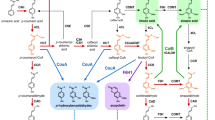Abstract
This paper summarizes our previous and current research on genetic engineering of lignin biosynthesis for the purposes of improving wood pulping and bleaching efficiency. For these purposes, our targets were to produce transgenic trees with low content of lignin that is also chemically reactive (high lignin S/G ratio). Using aspen as a model species, we have characterized the biochemical functions of various genes and the kinetic properties of these gene products involved in monolignol biosynthetic pathway. The results of these characterizations proved strong evidence for a principle phenolic flux leading to the formation of monolignols. Biochemical evidence further demonstrated that, in this principle flux, 4CL could be the enzyme limiting total lignin accumulation, whereas CAld5H might control the lignin S/G ratio. These propositions were fully supported by the in vivo functions of these enzymes. Transgenic trees with inhibited 4CL enzyme activity exhibited 5–45% reduction in lignin contents. The chemical structure of the resulting lignin remained essentially unchanged. More importantly, the lignin reduction was compensated for by a concomitant increase in cellulose content. When antisense 4CL and sense coniferaldehyde 5-hydroxylase (CAld5H) genes were simultaneously transferred into aspen via Agrobacterium, transgenic trees expressing each one and both of the transgenes were produced. Lignin reductions up to 55% were achieved in antisense 4CL plants and up to 3-fold S/G increases were observed in sense CAld5H plants. These effects were independent but additive, with plants expressing both transgenes having less lignin and higher S/G ratio. Consistent with our previous results, lignin reduction has always resulted in an increase in cellulose content. These transgenics could be potentially valuable for pulp production. But more importantly, these benchmark transgenics are rich sources of information for functional genomics and metabolic engineering, allowing the generation of the ultimate raw materials for wood pulp production.

Similar content being viewed by others
References
Grand C (1984) Ferulic acid 5-hydroxylase: a new cytochrome p-450-dependent enzyme from higher plant microsomes involved in lignin synthesis. FEBS Lett 169:7–11
Grisebach H (1981) Lignins. In: The biochemistry of plants, vol. 7. Academic Press, New York, pp 457–478
Higuchi T (1985) In: Higuchi T (ed) Biosynthesis and biodegradation of wood components. Academic Press, New York, pp 141–160
Hu W-J, Lung J, Harding SA, Popko JL, Ralph J, Stokke DD, Tsai C-J, Chiang VL (1999) Repression of lignin biosynthesis promotes cellulose accumulation and growth in transgenic trees. Nat Biotechnol 17:808–812
Hu W-J, Kawaoka A, Tsai C-J, Lung J, Osakabe K, Ebinuma H, Chinag VL (1998) Compartmentalized expression of two structurally and functionally distinct 4-coumaric acid:coenzyme A ligase (4CL) genes in aspen (Populus tremuloides). Proc Natl Acad Sci USA 95:5407–5412
Li L, Popko JL, Umezawa T, Chiang VL (2000) 5-Hydroxyconiferyl aldehyde modulates enzymatic methylation for syringyl monolignol formation, a new view of monolignol biosynthesis in angiosperms. J Biol Chem 275:6537–6545
Li L, Cheng XF, Leshkevich J, Umezawa T, Harding SA, Chiang VL (2001) The last step of syringyl monolignol biosynthesis in angiosperms is regulated by a novel gene encoding sinapyl alcohol dehydrogenase. Plant Cell 13:1567–1585
Li L, Zhou Y, Cheng XF, Sun J, Marita J, Ralph J, Chiang VL (2003) Combinatorial genetic reduction of lignin quantity and augmentation of lignin syringyl constituents in trees through multigene co-transformation. Proc Natl Acad Sci USA 100:4939–4944
Osakabe K, Tsao CC, Li L, Popko JL, Umezawa T, Carraway DT, Smeltzer RH, Joshi CP, Chiang VL (1999) Coniferyl aldehyde 5-hydroxylation and methylation direct syringyl lignin biosynthesis in angiosperms. Proc Natl Acad Sci USA 96:8955–8960
Author information
Authors and Affiliations
Corresponding author
Additional information
Selected articles from the XXII International Conference on Polyphenols, Helsinki, Finland, organized by Prof. Kristiina Wähälä.
Rights and permissions
About this article
Cite this article
Chiang, V.L. Monolignol biosynthesis and genetic engineering of lignin in trees, a review. Environ Chem Lett 4, 143–146 (2006). https://doi.org/10.1007/s10311-006-0067-9
Received:
Accepted:
Published:
Issue Date:
DOI: https://doi.org/10.1007/s10311-006-0067-9




